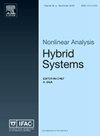Recurrence of nonlinear control systems: Entropy, bit rates, and finite alphabet controllers
IF 3.7
2区 计算机科学
Q2 AUTOMATION & CONTROL SYSTEMS
引用次数: 0
Abstract
In this paper, we introduce the notion of recurrence entropy in the context of nonlinear control systems. A set is said to be (-)recurrent if every trajectory that starts in the set returns to it (within at most units of time). The recurrence entropy of a control system quantifies the complexity of making a set -recurrent measured by the average rate of growth, as time increases, of the number of control signals required to achieve this goal. Our analysis reveals that, compared to invariance, recurrence is quantitatively less complex, meaning that the recurrence entropy of a set is no larger than, and often strictly smaller than, the invariance entropy. We provide upper and lower bounds on recurrence entropy and show that they converge to the bounds on invariance entropy as decreases to zero. Further, our results show that recurrence entropy lower bounds the minimum data rate between the sensor and controller required for achieving recurrence. We present an algorithm according to which the sensor can send state estimates to the controller over a limited-bandwidth channel to achieve recurrence asymptotically at an exponential rate. Finally, we show that, under mild stricter conditions on the set and dynamics, the control signals that enforce the -recurrence of a set can be generated by a finite alphabet of control signals of durations of at most units of time, which allows us to store them for quick online execution.
非线性控制系统的递归:熵、比特率和有限字母控制器
本文在非线性控制系统中引入了递归熵的概念。如果在集合中开始的每个轨迹都返回到它(最多在τ单位时间内),则称一个集合是(τ-)循环的。控制系统的递归熵量化了使一组τ-递归的复杂性,该复杂度由达到该目标所需的控制信号数量随时间增加的平均增长率来衡量。我们的分析表明,与不变性相比,递归在数量上不那么复杂,这意味着一个集合的递归熵不大于,而且通常严格小于不变性熵。我们提供了递归熵的上界和下界,并表明当τ减小到零时,它们收敛于不变性熵的上界和下界。此外,我们的结果表明,递归熵的下限是实现递归所需的传感器和控制器之间的最小数据速率。我们提出了一种算法,根据该算法,传感器可以在有限带宽信道上向控制器发送状态估计,以指数速率渐近地实现递归。最后,我们证明,在较严格的集合和动力学条件下,强制集合τ-递推的控制信号可以由持续时间最多为τ单位时间的有限控制信号字母表生成,这使我们能够将它们存储起来以便快速在线执行。
本文章由计算机程序翻译,如有差异,请以英文原文为准。
求助全文
约1分钟内获得全文
求助全文
来源期刊

Nonlinear Analysis-Hybrid Systems
AUTOMATION & CONTROL SYSTEMS-MATHEMATICS, APPLIED
CiteScore
8.30
自引率
9.50%
发文量
65
审稿时长
>12 weeks
期刊介绍:
Nonlinear Analysis: Hybrid Systems welcomes all important research and expository papers in any discipline. Papers that are principally concerned with the theory of hybrid systems should contain significant results indicating relevant applications. Papers that emphasize applications should consist of important real world models and illuminating techniques. Papers that interrelate various aspects of hybrid systems will be most welcome.
 求助内容:
求助内容: 应助结果提醒方式:
应助结果提醒方式:


